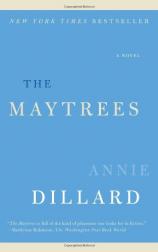The Maytrees
Review
The Maytrees
In
1973, Sweden’s Ingmar Bergman directed a film titled
Scenes from a Marriage, chronicling the stages of a
relationship that culminates in the divorce and eventual
reconciliation of the protagonists. That title could have served
equally well to describe Pulitzer Prize-winning author Annie
Dillard’s affecting second novel, THE MAYTREES.
The main action of THE MAYTREES takes place in and around
Provincetown, the famous artistic community on the tip of Cape Cod.
Although the novel’s time span is not spelled out with
precision, it encompasses roughly 40 years, beginning shortly after
World War II, when Toby Maytree, an aspiring poet and handyman,
meets Lou Bigelow, a woman he at first mistook for Ingrid Bergman,
“because everyone shows up in Provincetown sooner or
later.”
Soon, Toby and Lou are married and the parents of a son, Petie. To
all outward appearances, their relationship is idyllic and the
bonds that hold them together strong, until the day when Petie
suffers a broken leg in a bicycle accident and Toby chooses that
occasion to announce he’s leaving Lou after 14 years of
marriage to move to Maine with Deary Hightoe, a family friend and
something of an eccentric who is fond of sleeping on the beach,
swaddled in a canvas sail. Toby and Deary live contentedly in Maine
for 20 years, while Lou and Petie (known as “Pete” as
he becomes an adult and earns his living as a commercial fisherman)
must come to terms with Toby’s abandonment. Eventually,
circumstances reunite the characters in Provincetown, and their
relationships, in all their complexity, come full circle to bring
about a tender and moving resolution.
To some, Toby’s abandonment of his wife and young son will
appear inexplicable, but it serves as the underpinning for the
intriguing questions Dillard raises in her novel. There’s no
simmering conflict that eventually detonates with the announcement
of Toby’s departure, no torrid affair with Deary that
motivates him. Instead, Toby muses, he simply “fell in love,
love unlooked-for.” Dillard’s theme is marital love:
what causes that love to blossom and then endure over time, and why
does it sometimes slip away despite the best intentions of both
partners? “The feeling of love is so crucial to our
species,” she observes, “it is excessive, like labor
pain. Lasting love is an act of will. It is a gentleman’s
game.”
As befits a writer best known for her nature writing in classics
like PILGRIM AT TINKER CREEK and HOLY THE FIRM, THE MAYTREES is
laden with rich descriptive passages portraying the life of nature
on Cape Cod. In some ways, THE MAYTREES is an extended lyric poem,
filled with captivating imagery. Describing the winter sea, Dillard
writes, “Sky ran its candid lengths round the hoop of the
horizon. Weak swells spent themselves in muddy sea ice. A tide line
of frozen froth like lees stranded in the dead rye.” Or this:
“From a white lake of fog opaque as paint, the tips of dunes,
and only the tips of dunes, arose everywhere like sand peaks that
began halfway up the sky….They lacked nothing but connection
to earth and a cause for being loose. They looked like a rendezvous
of floating tents.”
Love endures, Dillard concludes, although in the end it may be
transfigured into forms barely recognizable to those who perceived
its dim outlines at the start. THE MAYTREES is quieter and less
turbulent than another classic exploration of married life, James
Salter’s LIGHT YEARS. And yet, in a fresh and original way it
probes the depths of human relationships, offering a tantalizing
glimpse at the truth of how the ties between women and men are
forged and tested.
Reviewed by Harvey Freedenberg on January 7, 2011
The Maytrees
- Publication Date: June 1, 2008
- Genres: Fiction
- Paperback: 240 pages
- Publisher: Harper Perennial
- ISBN-10: 0061239542
- ISBN-13: 9780061239540




